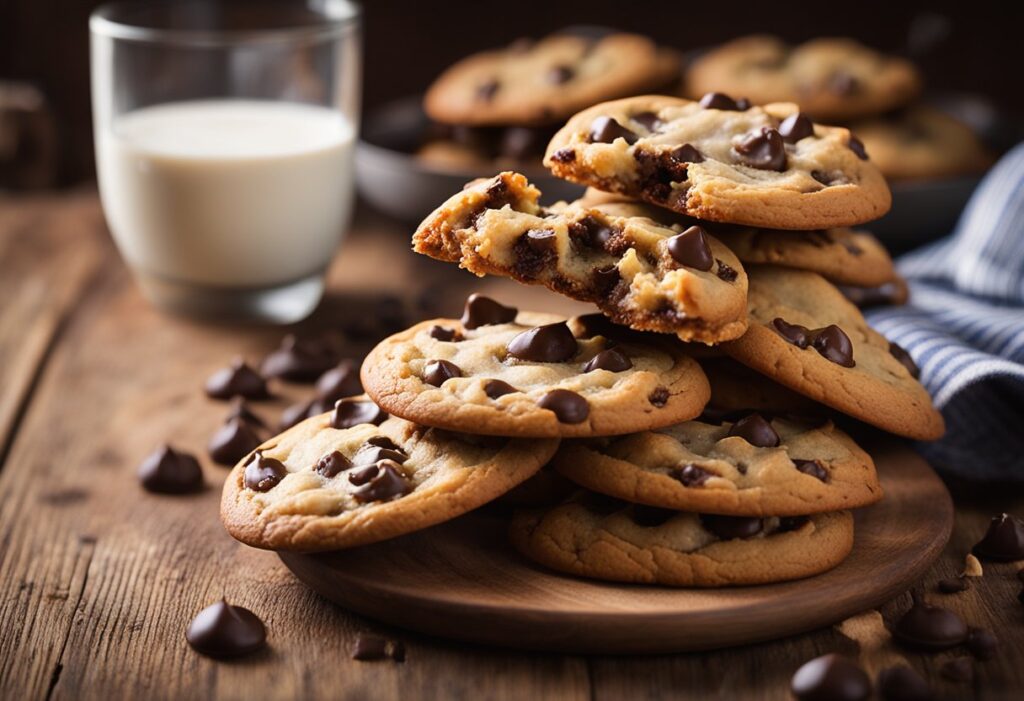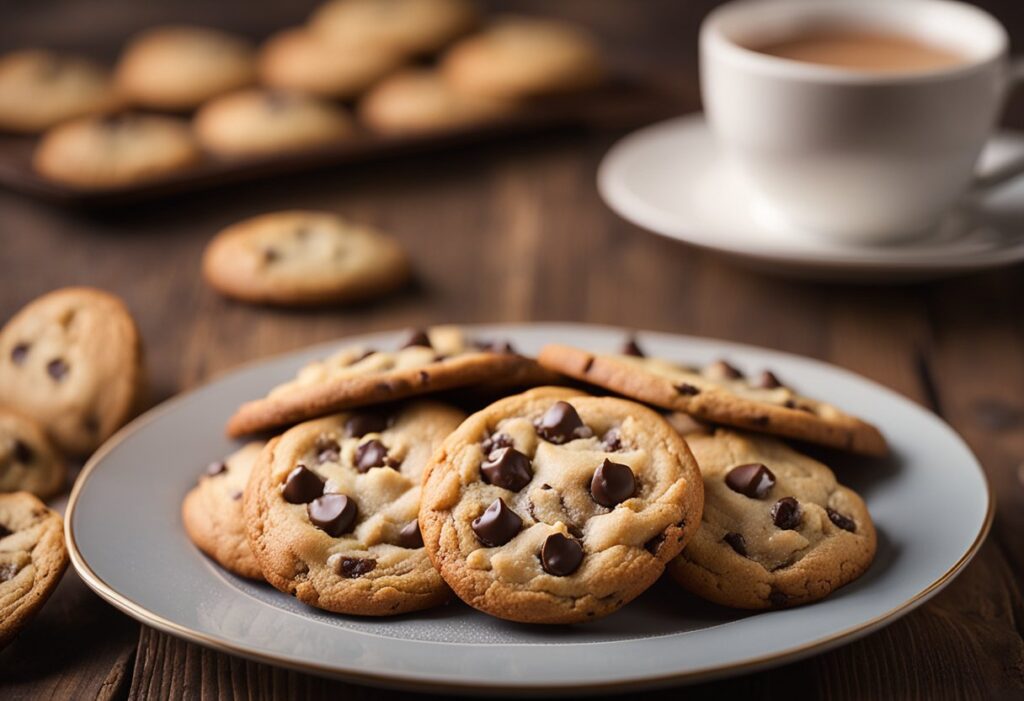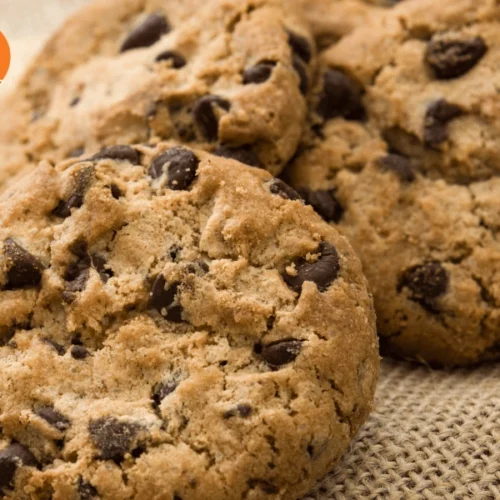Chocolate chip cookies are a beloved treat, but the dough itself often captures hearts even before baking. This chocolate chip cookie dough recipe promises a deliciously smooth and creamy base that is perfect for enjoying raw or baking into golden cookies. With just a few essential ingredients, anyone can create this classic favorite right at home.

The joy of chocolate chip cookie dough lies not only in its taste but also in its versatility. From adding extra chocolate chips to incorporating nuts or other mix-ins, this recipe can be tailored to fit any preference. Whether someone is a novice in the kitchen or a seasoned baker, the process remains straightforward and satisfying.
Engaging with the rich history of this recipe can transform the entire baking experience. Many people will appreciate how cookies evolved and why chocolate chip cookie dough continues to be a classic favorite today.
Key Takeaways
- This recipe for chocolate chip cookie dough is easy and adaptable.
- The dough can be enjoyed raw or baked for delicious cookies.
- Understanding the ingredients enhances the overall baking experience.
History of Chocolate Chip Cookies

The chocolate chip cookie began in the 1930s in the kitchen of Ruth Wakefield. She was the owner of the Toll House Inn in Massachusetts.
While making a Butter Drop Do cookie recipe, she added chopped chocolate. Originally, she thought the chocolate would melt completely. Instead, it held its shape and created gooey spots of chocolate in the baked cookies.
This new creation quickly gained popularity. The recipe was published in a local newspaper, spreading its fame beyond New England. By 1939, chocolate chip cookies were beloved across the country.
Nestlé recognized the growing demand. They struck a deal with Wakefield to print her recipe on chocolate bar packages. This partnership helped popularize chocolate chip cookies even more.
In the 1950s, refrigerated cookie dough became available in supermarkets. Brands like Nestlé and Pillsbury made it easy for everyone to enjoy fresh cookies without much effort.
Today, chocolate chip cookies are a staple in American baking. They are made in various forms, including soft, chewy, and crispy adaptations. This cookie’s history reflects its enduring popularity and appeal.
Essential Ingredients

The right ingredients are key to making delicious chocolate chip cookie dough. Each component plays a specific role in achieving the ideal texture, flavor, and consistency.
Chocolate Chip Cookie Dough Recipe
Equipment
- Mixing Bowls: 2 (one for wet ingredients, one for dry ingredients)
- Electric Mixer: For creaming butter and sugar (optional, but recommended)
- Measuring Cups and Spoons: For accurately measuring ingredients
- Spatula or Wooden Spoon: For mixing in the chocolate chips
- Cookie Scoop or Tablespoon: For portioning the dough onto baking sheets
- Baking Sheets: For baking the cookies
- Parchment Paper or Silicone Baking Mats: To line the baking sheets
- Wire Rack: For cooling the cookies
- Whisk: For mixing dry ingredients4o mini
Ingredients
- 1 cup (2 sticks) unsalted butter, softened
- 3/4 cup granulated sugar
- 3/4 cup brown sugar, packed
- 2 large eggs
- 1 tsp vanilla extract
- 2 1/4 cups all-purpose flour
- 1 tsp baking soda
- 1/2 tsp salt
- 2 cups semi-sweet chocolate chips
Notes
- Butter Consistency: Make sure the butter is softened, not melted. Softened butter creates a better texture for the cookie dough and helps achieve the right consistency for baking.
- Chilling the Dough: Chilling the dough for at least 30 minutes before baking can help prevent excessive spreading and improve the cookie’s texture. If you’re short on time, you can skip this step, but the cookies may spread more.
- Mix-Ins: Feel free to customize your cookies by adding other mix-ins like nuts (walnuts, pecans), dried fruit (cranberries, raisins), or even toffee bits.
- Baking Time: Keep a close eye on the cookies as they bake. For softer cookies, remove them from the oven when the edges are golden brown but the centers are still slightly soft. They will continue to cook slightly on the baking sheet after removal from the oven.
- Freezing Dough: You can freeze cookie dough for up to 3 months. Scoop the dough onto a baking sheet, freeze until firm, then transfer the dough balls to a freezer bag. When ready to bake, bake from frozen, adding a couple of extra minutes to the bake time.
- Oven Temperature: Ensure your oven is preheated to 350°F (175°C) for even baking. An oven thermometer can help if you’re unsure of your oven’s accuracy.
- Cooling: Let the cookies cool on the baking sheet for a few minutes before transferring them to a wire rack. This allows them to set and prevents them from breaking apart.
- Storing Cookies: Store baked cookies in an airtight container at room temperature for up to a week. For longer storage, freeze the cookies and thaw as needed.
Flour Types and Selection
Choosing the right flour is crucial for cookie dough. All-purpose flour is the most common choice, providing a balanced protein content for structure. For a softer texture, bakers may opt for cake flour, which has lower protein and results in a tender cookie.
Another option is bread flour, which has a higher protein content. This option can give the dough a chewier texture. For gluten-free options, almond or coconut flour can also work, but adjustments in liquid may be necessary.
Selecting flour that is fresh and properly stored ensures the best outcome.
Choosing the Right Chocolate
Chocolate chips are a core ingredient in cookie dough. The choice between semi-sweet, milk, or dark chocolate depends on personal preference. Semi-sweet chocolate chips are the classic choice, adding a balanced sweetness.
Milk chocolate offers a creamier and sweeter taste, while dark chocolate provides a richer flavor. Bakers can also use chocolate chunks for a different texture. Including a mix of chocolates can create a complex flavor profile, enhancing the overall taste experience.
Types of Sugar and Their Uses
Sugar affects both flavor and texture in cookie dough. Granulated sugar is the most common, contributing to sweetness and helping cookies spread. Brown sugar, which contains molasses, adds moisture and depth of flavor.
A mix of both sugars can yield a chewy cookie, with crisp edges. For added sweetness, powdered sugar can be incorporated, but it’s less common in traditional cookie recipes.
Using a precise measurement of sugars allows bakers to achieve the desired sweetness and texture for their cookies.
Role of Eggs in Baking
Eggs are essential in cookie dough for structure and moisture. They help bind ingredients, adding richness and flavor. Typically, large eggs are used, and they should be at room temperature for better incorporation into the dough.
Egg yolks add fat, making cookies softer and richer. For a lighter texture, some recipes use only egg whites. Adjusting the egg content can significantly change the cookie’s final texture.
Proper handling of eggs is important for food safety and achieving the desired baking results.
Importance of Fats: Butter vs. Alternatives
Fats play a vital role in cookie recipes, affecting flavor and texture. Butter is the traditional choice, providing a rich flavor and creamy texture. Using unsalted butter allows for better control of the overall saltiness in the dough.
Bakers may consider alternatives like margarine or coconut oil. Margarine can produce a similar texture but often lacks the depth of flavor that butter provides. Coconut oil adds a unique taste, but may also yield a different texture.
Experimenting with fats can lead to varied results, making it important for bakers to choose based on desired flavors and textures.
Equipment Needed

When preparing a chocolate chip cookie dough recipe, having the right equipment is essential. The right tools make the process easier and ensure the best results. This section covers the necessary mixers and spoons, measuring tools, and baking sheets and cooling racks.
Mixers and Spoons
Mixers play a crucial role in properly blending ingredients. An electric mixer, either handheld or stand, can save time and effort. It ensures that butter and sugars combine smoothly, creating a creamy texture.
For recipes that require precise control, a sturdy wooden spoon is invaluable. It can effectively mix the dough without overworking it. Silicone spatulas are also useful for scraping down the sides of the bowl to incorporate all ingredients evenly.
Using the right mixer avoids inconsistent dough that could lead to uneven baking results. Therefore, selecting quality mixers and durable spoons is critical.
Measuring Tools
Accurate measuring tools are vital for successful cookie dough. A set of dry measuring cups will ensure the right amount of flour and sugar is used. For liquids like milk and extracts, liquid measuring cups with clear markings help achieve precision.
Measuring spoons are equally important for smaller quantities of ingredients, such as baking soda and salt. A kitchen scale can provide the most accurate measurement, especially for flour, where weight can differ based on packing.
Using precise measuring tools ensures the right balance of flavors and textures in the dough. This attention to detail is necessary for the best cookie outcome.
Baking Sheets and Cooling Racks
Baking sheets must be sturdy and non-stick to prevent cookies from sticking. Using parchment paper or silicone mats can further ensure easy removal and cleanup. A half-sheet pan is standard for cookie baking and accommodates many cookies at once.
Cooling racks are essential for allowing cookies to cool evenly after baking. They promote airflow around the cookies, preventing them from becoming soggy. A stackable cooling rack can save space if working in a smaller kitchen.
Having quality baking sheets and cooling racks is important to achieve perfect cookies. These tools enhance the baking experience and ensure delicious results.
Preparing the Cookie Dough

This section will detail the important steps involved in preparing cookie dough. The methods used in mixing and resting the dough contribute significantly to the texture and flavor of the final product.
Mixing Techniques
When preparing cookie dough, using the right mixing techniques is crucial. First, creaming the butter and sugars together helps to incorporate air, resulting in a lighter texture. This process typically takes about 2-3 minutes with an electric mixer on medium speed.
Next, the eggs and vanilla extract are added and mixed until fully combined. Following this, the dry ingredients—including flour, baking soda, and salt—should be mixed separately and then gradually added to the wet mixture. This avoids overmixing, which can lead to dense cookies.
Lastly, he or she should fold in the chocolate chips gently to ensure they are evenly distributed without breaking. This step is important for achieving the desired chocolatey flavor.
Chilling and Resting the Dough
Chilling the cookie dough can dramatically improve the flavor and texture. After mixing, it is best to cover the dough and refrigerate it for at least 30 minutes. This step allows the fats to solidify, preventing the cookies from spreading too much during baking.
Resting the dough also enhances its flavor. As it sits, the ingredients meld together, intensifying the taste. Some bakers recommend resting the dough for up to 24 hours for even better results.
When ready to bake, the chilled dough can be scooped into portions. This helps in achieving uniform cookie sizes and ensures even baking. Following these steps will lead to delicious and well-textured chocolate chip cookies.
Safety and Storage
When handling cookie dough, safety and proper storage are essential to prevent foodborne illnesses and maintain freshness. This section focuses on raw dough safety and how to store chocolate chip cookie dough effectively.
Raw Dough Safety
Raw cookie dough contains ingredients like eggs and flour that can pose health risks. Eggs can carry Salmonella, while untreated flour may contain harmful bacteria. To minimize these risks, use pasteurized eggs in the recipe. This type of egg has been heat-treated to kill pathogens without cooking the egg.
Another option is to make edible cookie dough that omits eggs and uses heat-treated flour. To heat-treat flour, simply spread it on a baking sheet and bake at 350°F (175°C) for 5-10 minutes. Cool it before mixing it into the dough. Always advise people to avoid eating raw cookie dough made with traditional ingredients.
Storing the Dough
Storing chocolate chip cookie dough correctly ensures freshness and taste. For short-term storage, wrap the dough tightly in plastic wrap or place it in an airtight container. It can safely stay in the refrigerator for up to three days.
For longer storage, freeze dough balls or logs. Wrap individual portions thoroughly, then store them in a freezer-safe bag. Cookie dough can last in the freezer for 2-3 months. When ready to bake, move the dough to the refrigerator and let it thaw overnight. This way, the cookie dough remains fresh and safe for consumption.
Customizing Your Cookie Dough
Making chocolate chip cookie dough is a fun experience that allows for plenty of creativity. By making specific changes, one can tailor the dough to suit personal tastes and dietary needs. Below are ways to modify the cookie dough, focusing on variations and potential enhancements.
Variations and Substitutions
When customizing cookie dough, variations and substitutions can play a significant role. For those who prefer different flavors, one option is to swap regular all-purpose flour with whole wheat or almond flour. This can add a unique taste and make the dough healthier.
Another idea is to replace granulated sugar with alternatives like coconut sugar or honey. These swaps can change the sweetness profile without compromising texture.
For dietary restrictions, omitting eggs is easy. People can replace eggs with unsweetened applesauce or a mashed banana, which can still provide moisture. Choosing to leave out gluten altogether is also possible by utilizing gluten-free flour blends.
Add-Ins and Flavor Enhancers
Adding special ingredients can elevate standard chocolate chip cookie dough. Including a variety of chocolate types, such as dark, milk, or white chocolate chips, can create a more complex flavor experience.
In addition to chocolate chips, try incorporating nuts like walnuts or pecans for added crunch. Dried fruit, such as raisins or cranberries, can introduce a new sweetness.
Flavor enhancers such as vanilla extract or a hint of almond extract can deepen the taste. Using spices like cinnamon or nutmeg offers another layer of flavor that pairs wonderfully with chocolate.
Being creative with these options can lead to unique combinations that are sure to please.
Baking the Perfect Chocolate Chip Cookies
Baking chocolate chip cookies requires attention to detail and understanding of key factors that influence texture and taste. From the ideal oven temperature to cookie size, various elements play a crucial role in achieving delicious results.
Oven Temperature and Timing
Proper oven temperature is vital for baking perfect chocolate chip cookies. A temperature of 350°F (175°C) is widely recommended. This level allows the cookies to bake evenly, creating a crispy edge while keeping the center chewy.
Timing is also critical. Most cookies take about 10 to 12 minutes to bake, but this can vary based on size and oven type. It’s essential to monitor visually; cookies should appear slightly underbaked when removing from the oven, as they continue cooking on the baking sheet.
To ensure a consistent bake, it’s beneficial to rotate the baking sheet halfway through the cooking time. This helps avoid uneven baking caused by hot spots in the oven.
Cookie Size and Thickness
The size and thickness of the cookie significantly affect the final texture. For a classic chocolate chip cookie, aim for about 2 tablespoons of dough per cookie. This size allows for a balanced bake, ensuring the inside stays soft while the edges crisp up.
Thicker cookies often need a bit more time in the oven, so adjustments may be necessary. Using a cookie scoop can help maintain uniformity in size. If thinner cookies are preferred, flatten the dough slightly before baking for a different texture.
Tip: Chilling the cookie dough for at least 30 minutes before baking can enhance the cookie’s flavor and prevent spreading.
Troubleshooting Common Issues
Even with the best recipes, problems can arise. If cookies spread too much, it may be due to using melted butter or not chilling the dough. Ensure butter is softened but not liquid for optimal results.
If cookies turn out too hard, it could be a result of overbaking. Always rely on visual cues, and do not hesitate to adjust baking times.
Lastly, for cookies that are too crispy, consider adding a bit more brown sugar. Brown sugar retains moisture, leading to a softer cookie.
By paying attention to these factors, anyone can bake chocolate chip cookies that are perfectly balanced in flavor and texture.
Nutritional Considerations
When preparing a chocolate chip cookie dough recipe, it is important to consider the nutritional aspects. Understanding the caloric content and exploring healthier substitutes can help individuals make informed choices that fit their dietary needs.
Caloric Content
Chocolate chip cookie dough can be high in calories due to its ingredients. Common ingredients include butter, sugars, and flour, which contribute significantly to the total calorie count. For example, a typical serving can range from 150 to 200 calories.
A standard recipe might include:
- Butter: 100 calories per tablespoon
- Sugar: 50-60 calories per tablespoon
- Flour: About 30 calories per tablespoon
These values can vary based on specific brands and methods of preparation. Individuals should be mindful of portion sizes to manage calorie intake effectively.
Healthy Substitutes
There are several healthy substitutes that can reduce calories and enhance nutrition. Incorporating alternatives can keep the dough delicious without compromising health.
- Nut Butters: Using almond or peanut butter instead of butter can provide healthy fats and protein.
- Whole Wheat Flour: This option adds fiber and nutrients compared to all-purpose flour.
- Natural Sweeteners: Sweeteners like honey or maple syrup can replace refined sugars for a healthier profile.
- Greek Yogurt: This can serve as a partial butter substitute, adding protein and reducing fat.
These substitutions not only lower calorie counts but also boost the nutritional value of the cookie dough, making it a guilt-free treat.
Serving Suggestions
When serving chocolate chip cookie dough, it’s important to enhance the experience with complementary beverages and appealing presentation. These suggestions will elevate the enjoyment of this treat.
Pairing with Beverages
Selecting the right beverage can enhance the flavor of chocolate chip cookie dough. Popular options include:
- Milk: A classic choice that balances the sweetness.
- Coffee: The bitterness of coffee contrasts nicely with the sweetness of cookie dough.
- Hot Chocolate: For chocolate lovers, this drink adds extra richness.
For a more unique twist, consider pairing with a sweet dessert wine, such as Moscato, which can bring out the flavors of the sugars. Sparkling water with a slice of lemon can also cleanse the palate between bites.
Dessert Presentation Ideas
Presentation can make chocolate chip cookie dough more enticing. Consider these ideas:
- Serving in Bowls: Use small, decorative bowls to serve individual portions, making it feel special.
- Garnishing: Top with chocolate chips, a sprinkle of sea salt, or crushed nuts for added texture and flavor.
- Creative Plating: Place a scoop of cookie dough on a dish and drizzle with chocolate syrup or caramel for a gourmet touch.
Using colorful spoons or fun plates can also add a playful element to the presentation, making it more appealing for casual gatherings or parties.
Frequently Asked Questions
This section addresses common inquiries related to chocolate chip cookie dough. It provides specific methods, tips, and ingredients to enhance the cookie-making process.
What is the traditional method for making chocolate chip cookie dough?
The traditional method involves creaming softened butter with sugars until light and fluffy. Next, eggs and vanilla are added, followed by dry ingredients like flour, baking soda, and salt. Finally, chocolate chips are mixed in to complete the dough.
How can I ensure my chocolate chip cookies turn out soft and chewy?
To achieve soft and chewy cookies, it is essential to use brown sugar alongside granulated sugar. Chilling the dough for at least 30 minutes before baking can also help. Baking at a lower temperature for a shorter time contributes to a chewier texture.
What are the key ingredients in a classic chocolate chip cookie dough recipe?
Key ingredients include all-purpose flour, unsalted butter, granulated sugar, brown sugar, eggs, vanilla extract, baking soda, salt, and chocolate chips. Each ingredient plays a vital role in texture and flavor.
Is there a recommended way to thicken cookie dough if it’s too sticky?
If the dough is too sticky, gradual additions of flour can help thicken it. It is important to do this little by little to avoid making the dough overly dry while achieving the desired consistency.
What causes chocolate chip cookie dough to become too wet, and how can it be fixed?
Excess moisture in cookie dough can result from too much butter or liquid ingredients. To fix this, additional flour can be added until the desired dough consistency is achieved. It’s also helpful to measure ingredients accurately.
What are some common variations to the basic chocolate chip cookie dough recipe for different textures and flavors?
Variations can include using different types of chocolate, such as dark or white chocolate. Adding nuts, oatmeal, or spices can create different textures and flavors. Adjusting the ratios of sugars can also impact the final cookie texture, making it either chewier or crisper.


